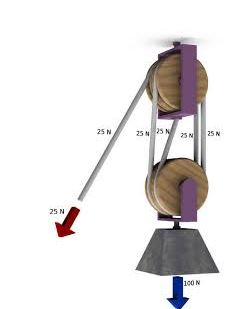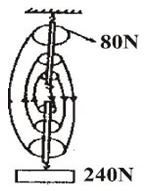Notes on Simple Machine

Notes on simple machine
MACHINES
A machine is any device by means of which work can be done more conveniently.
Mechanical Advantage (M.A.)
The M.A. of a machine is defined as the ratio of load to the effort
Mechanical Advantage (M.A.) = load / effort
Velocity Ratio (V.R.)
The velocity ratio V.R. of a machine is defined as the distance moved by the effort to the distance moved by the load.
Velocity Ratio (V.R.) = distance moved by the effort / distance moved by the load
Efficiency
The efficiency of a machine is the ratio of the useful work done by a machine to the total work put into the machine.
i.e. Efficiency = ( workout / workinput)*100%
Also, Efficiency = (M.A /V.R)*100%
THE LEVER
A lever is a simple machine. It consists of a rigid body which is pivoted about a point called the fulcrum. The lever is based on the principle of moment. The V.R is the ratio of the two arms of the lever.
1st class Lever
The fulcrum (F) is between the load (L) and the effort (E). The velocity ratio is usually greater than 1 but could be less than or equal to 1.
Examples of First Order Lever are: See-saw, crowbar, claw hammer, pliers, a pair of scissors or pincers.
2nd Class Lever
The load is between the fulcrum and the effort. M.A and V.R are always greater than 1.
Examples of Second order lever are: nutcracker and wheelbarrow.
3rd Class Lever
The effort is between the fulcrum and the load. M.A and V.R are less than 1.
Examples of third order lever are: forearm, forceps, sugar tongs, and table knife.
THE PULLEYS
A pulley is a wheel with a grooved rim, and there can be several of these mounted in a framework called a block. The effort is applied to a rope which passes over the pulleys.
THE BLOCK AND TACKLE
The block and tackle is the type of pulley system used in cranes and lifts. It consists of two blocks each with one or more pulleys

In a block and tickle system the V.R is always equal to the total number of pulleys in the two blocks together.
INCLINED PLANE
A heavy load may be raised more easily by pulling it along a sloping surface than by lifting it vertically. If l is the length of the plane and h its height, then;
V.R = L /h
For a perfect inclined plane, Load x distance moved by load = Effort x distance moved by effort
In the right–angle triangle
V.R = 1 /Sin θ
THE WHEEL AND AXLE
V.R = R / r = radius of wheel / radius of axle
Recommended: Solved questions on simple machine
